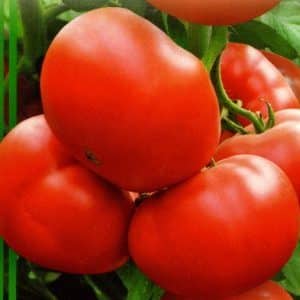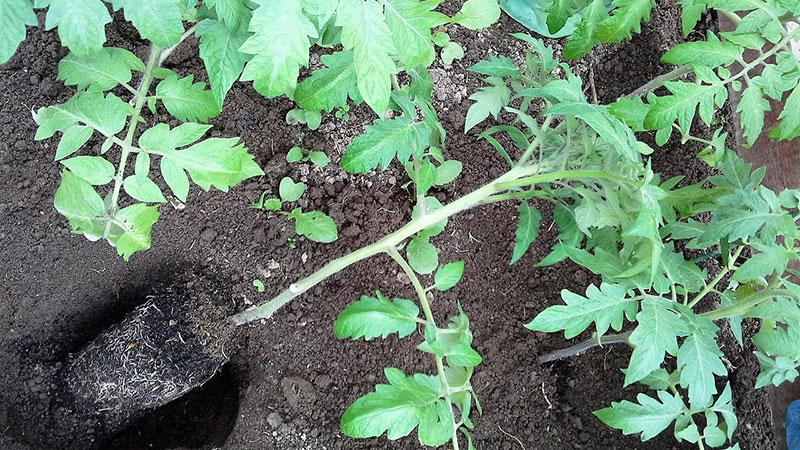Large-fruited and early-ripening hybrid for universal use - tomato “Strega f1”
The hybrid tomato Strega f1 is in demand among gardeners due to its high yields and unpretentiousness in agricultural technology.
We will tell you in detail about growing tomato seedlings and further caring for the plant, as well as possible problems and ways to solve them.
Description of the hybrid
The main features of Strega tomatoes are that the bushes are tall and form many shoots. The plant is not susceptible to fungal diseases, but for prevention purposes it is necessary to remove the lower leaves up to 1/3 of the height of the bush.
Distinctive features
Tomato Strega is characterized by the following characteristics:

- early ripening large-fruited hybrid, indeterminate;
- 3 months pass from the first shoots to the appearance of fruits;
- the plant is strong, the internodes are short;
- the first inflorescences are laid above the ninth leaf blade;
- up to 6 fruits are formed in one cluster, while on the upper clusters the size of the tomatoes is maintained;
- Suitable for growing in all types of greenhouses, as well as in open ground.
Fruit characteristics, yield indicators
The fruits of the Strega f1 hybrid have the following features:
- the shape of the tomatoes is round, they are flat on top and bottom;
- medium ribbed;
- The color of the fruit is deep red;
- the weight of one tomato reaches 200–250 g;
- The fruits are dense, while their flesh is fleshy and juicy.
Reference! The yield of Strega tomato per 1 square meter is 20-25 kg.
How to grow seedlings
Sowing of seeds is carried out no earlier than 60 days before planting in open ground. Only in this case can you grow beautiful, healthy, but not overgrown seedlings.
Seed preparation
Hybrid seeds do not require culling. However, it will not be superfluous to disinfect the seed material.
There are several options for this procedure:
- Place the seeds placed in a gauze bag into a weak solution of potassium permanganate;
- soak the seeds in the Fitosporin solution;
- soak the seeds in a soda solution (a teaspoon of soda per glass of water) - this procedure will not only destroy pathogens, but will also speed up the emergence of seedlings.
After disinfection, it is recommended to immerse the seeds in a growth stimulator for a day.
Attention! To prepare solutions, use settled, rain or melt water.
Container and soil
Ready-made store-bought soil for indoor plants is suitable for growing seedlings. You can also prepare the soil mixture yourself.
To do this you will need the following components:
- peat;
- compost or humus;
- turf or leaf soil;
- sand (it is best to take river sand - it is coarser).
Reference! Sand is taken in half as much as other components.
To 10 liters of soil mixture add a glass of wood ash (can be replaced with crushed chalk), as well as a tablespoon of mineral fertilizers. All ingredients are thoroughly mixed.
The substrate also needs to be disinfected. To do this, place it in the oven preheated to 100°C for 60 minutes.
As a container for planting, it is best to choose peat pots, tablets or special boxes and cassettes for seedlings.
Sowing
Small holes are made at the bottom of the planting container. After this, soil is poured there.Seeds are planted in the soil to a depth of 1 cm, with a distance between seeds of 3 cm. 3–6 seeds can be placed in peat pots, and 2–4 in tablets.
It is better to spill the soil with water in advance so as not to wash out the seeds with a stream of water. The containers are covered with film or glass and placed in a warm room. The optimal temperature for seeds is 28–30°C.
Attention! You cannot place containers on batteries.
Every day the film is opened for a few minutes. When the first sprouts appear, it is removed.
Growing and caring for seedlings
With the appearance of the first shoots, the seedlings are transferred to a cool place with a temperature of 16–18°C. After 7–10 days, the sprouts are transferred again to a warm place with a temperature of 20–22°C; at night it should be cooler – 14–16°C.
Important! Protect seedlings from drafts.
 Rules for caring for seedlings:
Rules for caring for seedlings:
- Watering. The roots of tomato seedlings are delicate, so water the sprouts carefully, along the edges of the container; use a watering can without a nozzle. It is also necessary to spray the plant once a day, twice on dry days.
- Lighting. Young sprouts require a lot of light, so it is recommended to place the seedlings on a southern windowsill or loggia. If there is a lack of natural light, a phytolamp is used. The containers are rotated periodically so that the plants do not pull in one direction.
- Dive. If the seedlings are located too densely, they need to be planted immediately after the first leaves appear. The sprouts are transplanted to a depth of 3-4 cm with a distance between them of 5–7 cm. The seedlings are planted together with a lump of earth. After 20–22 days, repeat diving is carried out in a larger container.
- Top dressing. 15–20 days after the first shoots, the seedlings are fed. Feeding is carried out regularly, every 10 days.You can choose ready-made complex fertilizers, or you can take wood ash, eggshells or chicken droppings.
Reference! Fertilizers are applied after moistening the soil in the morning or evening.
How to grow tomatoes
To grow a rich and tasty harvest of Strega f1 tomatoes, follow our recommendations.
Landing
It is best to plant seedlings in open ground in cloudy weather or in the evening. The distance between the rows is 50–70 cm, and the sprouts are spaced 30–40 cm apart from each other.
Landing algorithm:
- Make holes 15 cm deep.
- Sprinkle each hole with plenty of water.
- Plant the seedlings, deepening them to the cotyledon leaves.
- Sprinkle the seedlings with soil, compact it so that the sprouts do not fall.
Important! Overgrown seedlings are tied to stakes.
Seedling care
Basic procedures for obtaining a rich harvest:
- Watering. There is no need to water the first week after planting the seedlings, because the sprouts need to take root. Then watering is carried out as the soil dries. The optimal water consumption for 1 bush is 2–5 liters. Tomatoes are watered only at the root, and not from above. It is recommended to loosen it every time the soil is moistened.
- Top dressing. Fertilizers are applied for the first time 15–20 days after planting the seedlings. To do this, use ready-made complex formulations and prepare the solution in accordance with the instructions. The tomatoes are fed the second time after the first flowering and during the formation of buds. Fertilize the third time during the appearance of the first fruits.
- Stepsoning And pruning. Stepchildren take nutrients from plants, so they need to be removed. If this is not done, the growth of tomatoes and their fruiting will slow down, and may even stop altogether.Experts advise getting rid of unnecessary shoots exclusively with your fingers, without using pruners and scissors, while leaving stumps 1 cm long. Also, the Strega hybrid gets rid of the lower leaves - this procedure is performed after the first ovaries appear. Trimming the lower leaves is done with pruners or scissors.
- Garter. As soon as the bush grows above 50 cm, it is recommended to tie it up. It is best to use trellises.
Features of cultivation and possible difficulties
In equipped greenhouses, Strega f1 tomato is grown even in winter. The culture is unpretentious to climatic conditions.
In open ground, it is not recommended to plant seedlings in a sunny place, otherwise the leaf blades will be burned. It is better to choose partial shade. Tomatoes should be protected from drafts. You cannot plant seedlings in a wetland. This will cause the stems and leaves to rot.
Diseases and pests
You should be concerned if spots appear on the leaf blades and fruits. The appearance of mold on the leaves is also dangerous. If such diseases occur, the affected parts must be removed and then the plant must be treated with fungicides.
The hybrid is resistant to the following diseases:
- fusarium;
- withering;
- late blight;
- tobacco mosaic virus.
The best remedies for tomato diseases are prevention (disinfection of seeds and soil, loosening, weeding) and proper agricultural technology.
The nuances of growing in open ground and greenhouses
When growing Strega tomatoes, you should consider the following points:
- seeds are sown in mid-March;
- a week before planting seedlings, they need to be hardened off;
- in May it is better to plant seedlings under film, in June - in open ground;
- the plant needs constant watering, fertilizing and loosening.
In a greenhouse, plantings require regular ventilation. To improve pollination, it is recommended to shake the bushes periodically.
Harvesting and application
They begin to harvest in early August and continue to harvest ripe tomatoes until mid-September.
Most often, Strega tomatoes are used fresh; they are well suited for appetizers, salads and sandwiches. Tomatoes can also be used to make hot sauces and soups.

Advantages and disadvantages of the type
The main advantages of the Strega f1 hybrid:
- good formation of ovaries at different temperatures;
- excellent taste;
- presentation and transportability;
- resistance to many diseases.
Agronomists have not identified any serious deficiencies in the Strega tomato.
Farmer reviews
Sergey, Belgorod: “I plant the Strega f1 hybrid every year for sale. These are the tomatoes that are taken away from me first. I use mulch to retain moisture in the soil.”
Natalya, Vladimir: “I planted Strega for the first time on the recommendation of a friend. I watered the tomatoes generously, three times a week. The harvest result exceeded all my expectations. The tomatoes came out smooth and beautiful, just like in the photo of the packet of seeds.”
Evgenia, Zlatoust: “Strega produces an excellent harvest even in a bad year. The bushes grow powerful and delight with an abundance of ovaries. I plant tomatoes at a distance of 1 m from each other.”
Conclusion
Tomato Strega f1 is a real find for gardeners. The hybrid does not require special growing conditions, is unpretentious to climatic conditions, but at the same time produces a rich harvest of beautiful and tasty fruits.
Tomatoes have an excellent presentation and tolerate transportation well. Suitable for fresh consumption and for sauces and soups.